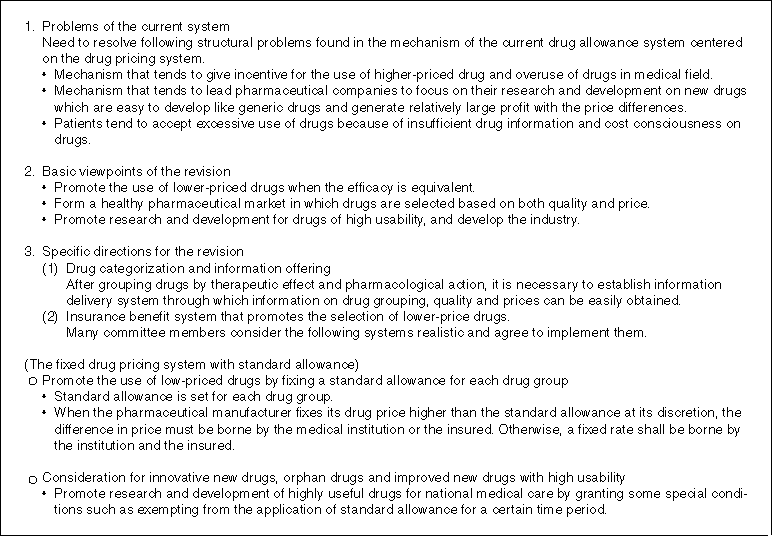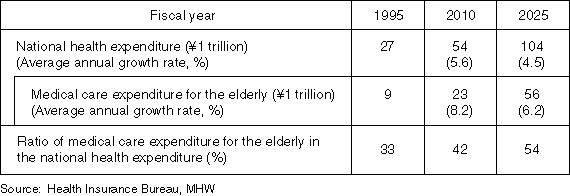
Aiming at the implementation of reform starting in fiscal 2000, the Ministry of Health and Welfare is currently examining the following issues to conduct comprehensive and radical reviews of the entire medical insurance system. These issues are mutually related and they are reviewed together.
(1) Review of the scheme of medical fee schedule
The current medical fee schedule was introduced in 1958 when many patients were in their acute stage of disease. However, as current patients tend to have chronic diseases, the schedule is no longer suitable. It is also pointed out that the principle of fee-for-service adopted in the current system is creating problems such as excessive medical treatments. In addition, while most physicians were directly providing medical care in their own clinics when the current fee schedule was introduced, hospitals now have heavier weight as medical care provider. The current fee schedule is no longer evaluating the overall functions of medical institutions sufficiently. Considering these issues, it is pointed out that the evaluation should be based on the characteristics of diseases and on the function of individual medical institutions with consideration of changes in disease patterns.
To respond to these issues, starting in November 1997 the System Planning Committee of the Council on Medical Insurance Welfare began investigating the basic framework on reform of the medical fee schedule including the introduction of evaluation system to meet the function of medical institutions and fixed amount system for individual disease type. On January 13, 1999, the "Working Group for Reviewing the Medical Fee Schedule", a subgroup within the System Planning Committee, submitted a report to the System Planning Committee. Then, the System Planning Committee discussed on the issue based on the report, and formulated a report, "Opinions on the Medical Fee Schedule", on April 16,1999. In next steps, the Central Social Insurance Medical Council will discuss on the details of the medical fee schedule with consideration of this report.
(2) Reviewing the drug pricing system
Regarding the current drug pricing system, the following concerns have been raised in relation to the drug price difference (the gap between the actual price at the time of purchase by the medical institution and the drug price used for the calculation of reimbursement to the medical institution from the insurer): 1 strong incentives for using expensive drugs or excessive use of drugs, 2 strong incentives for research and development that focus on new drugs which do not have much new efficacy but can be developed easily and will generate large profit through the difference in drug price, and 3 patients tend to accept a large volume of drugs because of insufficient information and the lack of cost consciousness on drugs.
Considering these issues, the System Planning Committee started discussions on the review of the drug pricing system in January 1998, and the "Task Team for Revising the Drug Pricing System" was organized within the System Planning Committee, and a report was submitted to the System Planning Committee on October 23 of the same year. Then, based on the report, consultations and hearings with relevant organizations were conducted, and then on January 7, 1999, a report "Opinions on Drug Allowance" was compiled. The report recommends to abolish the current drug pricing system and to introduce a system to set the standard value of the benefit provided by the medical insurers for each drug group based on the actual market price (a fixed drug pricing system with standard allowance). The report also includes the opinions against this system.
The Joint Meeting with the Study Group for Basic Medical Issues and the Social Issue Group in the Liberal Democratic Party has also investigated various options for the drug pricing system including the fixed drug pricing system with standard allowance, and in April 1999 it decided to proceed reform based on the third idea, that is different from the fixed drug pricing system with standard allowance, etc. with the direction of reform to aim at the elimination of profit-making price differences and to stabilize the operation through proper assessment of technical fees so that medical institutions can stop relying on the profit generated by the price gaps.
The Ministry of Health and Welfare will examine the details of revision to the system in discussion with ruling party.
Table 3-2-1. Overview of "Opinions on Drug Allowance"

Table 3-2-2. Future Projection of National Health Expenditures (Projection in 1997)

(3) Reviewing the medical care system for the elderly
Per capita medical expenditure for the elderly (age 70+) is five times greater than that of non-elderly people (age under 70), and with the progress of aging society the medical expenditure for the elderly is increasing rapidly. The medical expenditure for the elderly is already taking 1/3 of national health expenditure, and it is projected that its portion will reach 1/2 of national health expenditure around year 2025. If this condition continues with the current health care system, the burden on younger generations for the medical expenditure for the elderly will further expand. In order to realize fair sharing of the medical expenditure for the elderly by all citizens, it is necessary to improve the efficiency of the medical expenditure for the elderly and to balance the burden on non-elderly people and elderly people.
Regarding the current health service system for the elderly, following problems have been pointed out: 1 increasing burden of contribution for health services for the elderly borne by individual medical insurers is pressuring the management of their medical insurance, 2 current calculation method for the contribution for health services for the elderly is a problem in a view of fair burden among insurers, 3 while municipalities are providing the benefits for the medical expenditure for the elderly, the cost is borne by individual insurers in a form of contribution for health services for the elderly and this mechanism creates ambiguity in financial and management responsibilities, and 4 while importance of health care starting in young age is increasing, the current system is not responding to this concept sufficiently.
Considering these concerns, the System Planning Committee investigated the issues on the medical care system for the elderly starting in May 1998, and compiled a report, "Opinions on Health and Medical Care System for the Elderly" on November 9, 1998. The report recommends to take preventive measures focusing on healthy living when the elderly can live in good health without being bedridden, and to realize health care and medical care that is suitable to the elderly. It also presents two concepts for new medical care system for the elderly. One is a system in which all medical care for the elderly is completely separated from other medical care, and the other is a system in which medical expenditure for the elderly is borne separately by employees' insurance and the National Health Insurance.
2. A Temporary Special Measure on Co-Payment on Drugs for the Elderly
With the amendment to the Health Insurance Law, etc., in 1997, co-payment on drugs for outpatients was introduced. However, at the end of December 1998, during the discussion on 1999 budget formulation process by the Government and ruling party, the severe condition of current economy was considered comprehensively, and the implementation of a temporary measure was decided as an emergency measure before radical reform of the medical insurance system with the content that the Government shall bear the co-payment of drugs for the elderly in fiscal 1999 (To be implemented in July 1999).
Regarding the financial impact on medical insurers as a result of this measure, the Government will certainly take necessary measures to prevent the increase of premium payment.
Table 3-2-3. Overview of "Opinions on Health and Medical Care System for the Elderly"
(1) What is the medical care suitable to the elderly?
(1) Realizing health and medical care focusing on quality of life
(2) Basic framework for the new system
|